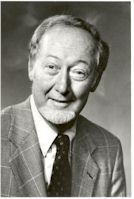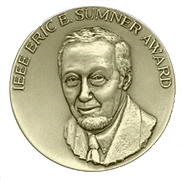Eric E. Sumner: Difference between revisions
No edit summary |
No edit summary |
||
| (16 intermediate revisions by 6 users not shown) | |||
| Line 1: | Line 1: | ||
{{Biography | |||
|Image=Eric E. Sumner.jpg | |||
|Birthdate=1924/12/17 | |||
|Birthplace=Vienna, Austria | |||
|Death date=1993/01/19 | |||
|Associated organizations=[[Bell Labs]] | |||
|Fields of study=Communications | |||
|Awards=IEEE Alexander Graham Bell Medal | |||
|Abstract=worked at Bell Labs from 1948 to 1989. He led the group that developed the pulse code modulation (PCM) transmission system (1955), and later director of transmission systems (1960) that developed the T1 carrier system (1962). | |||
|Organization=IEEE | |||
|StartYear=1991 | |||
}} | |||
Eric E. Sumner was born in Vienna, Austria, December 17, 1924. He emigrated to New York as a boy and attended Brooklyn Technical High School. In 1948 he received a B.S. degree in Mechanical Engineering from the Cooper Union in 1948. He furthered his education at Columbia University, earning an M.A. in Physics in 1953, and a professional degree in Electrical Engineering in 1960. | Eric E. Sumner was born in Vienna, Austria, December 17, 1924. He emigrated to New York as a boy and attended Brooklyn Technical High School. In 1948 he received a B.S. degree in Mechanical Engineering from the Cooper Union in 1948. He furthered his education at Columbia University, earning an M.A. in Physics in 1953, and a professional degree in Electrical Engineering in 1960. | ||
After joining [[Bell Labs|Bell Laboratories]] in 1948, Sumner did a number of analytical studies and designs of electromagnetic switching apparatus. In 1952, he turned to electronic switching circuits and soon joined a new organization formed to develop the first electronic switching system. In 1955, he became head of a new organization to develop a pulse code modulation (PCM) transmission system for exchange trunks. Introduced in 1962, the T1 carrier system started the digital era in commercial communications. | |||
After joining [[Bell Labs|Bell Laboratories]] in 1948, Sumner did a number of analytical studies and designs of electromagnetic switching apparatus. In 1952, he turned to electronic switching circuits and soon joined a new organization formed to develop the first electronic switching system. In 1955, he became head of a new organization to develop a pulse code modulation (PCM) transmission system for exchange trunks. Introduced in 1962, the | |||
In 1960, Sumner became Director of Transmission Systems concerned with expansion of the PCM hierarchy and improvements in microwave, coaxial, and wire systems. Between 1962 and 1967, he served as Director of the Underwater Systems Laboratory, charged with development of antisubmarine surveillance systems. In 1967, he became Executive Director of the Transmission Media Division, and in 1971 of the Loop Transmission Division with responsibility for all methods, software, and hardware for loop -about 20% of the Bell System network. | In 1960, Sumner became Director of Transmission Systems concerned with expansion of the PCM hierarchy and improvements in microwave, coaxial, and wire systems. Between 1962 and 1967, he served as Director of the Underwater Systems Laboratory, charged with development of antisubmarine surveillance systems. In 1967, he became Executive Director of the Transmission Media Division, and in 1971 of the Loop Transmission Division with responsibility for all methods, software, and hardware for loop -about 20% of the Bell System network. | ||
Sumner was very active in the IEEE, where he was a [[IEEE Fellow Grade History|Fellow]], and served as Vice President for Technical Affairs of the Communications Society, Chairman of the Policy Board and on the Nominations and Selection Board, and Chairman of the Strategic Planning Committee. His professional involvement also extended to various universities, advising Georgia Technical School of Electrical Engineering, Cooper Union, the University of Virginia, and the University of California at Davis. Beginning in 1991, he served as Chairman of the New Jersey Inventors Hall of Fame, which honors those who have advanced technology. That year he was also [[Presidents of the Institute of Electrical and Electronics Engineers (IEEE)|president of the IEEE]]. | |||
[[Image:SumnerAward.gif|thumb|right|IEEE Eric E. Sumner Award]] | |||
Sumner was recognized with a number of awards including the 1979 IEEE Alexander Graham Bell Medal, along with John S. Mayo and M. Robert Aaron "For personal contributions to, and leadership in, the practical realization of high-speed digital communications." He received the 1988 Computer and Communications Prize from the NEC Corporation, the Gano Dunn Medal for Engineering Achievement from Cooper Union, and the Cooper Union Distinguished Alumni Citation. In 1985, he was elected into the National Academy of Engineering. The IEEE established the [ | Sumner was recognized with a number of awards including the 1979 [[IEEE Alexander Graham Bell Medal History|IEEE Alexander Graham Bell Medal]], along with [[John S. Mayo|John S. Mayo]] and M. Robert Aaron "For personal contributions to, and leadership in, the practical realization of high-speed digital communications." He received the 1988 Computer and Communications Prize from the NEC Corporation, the Gano Dunn Medal for Engineering Achievement from Cooper Union, and the Cooper Union Distinguished Alumni Citation. In 1985, he was elected into the National Academy of Engineering. The IEEE established the [[IEEE Eric E. Sumner Award|Eric E. Sumner Award]] for outstanding contributions to communications technology in 1995. Sumner died on January 19, 1993.<br> | ||
== Further Research == | == Further Research == | ||
[http://books.nap.edu/openbook.php?record_id=4779&page=229 Memorial Tributes: National Academy of Engineering, Volume 7]. (National Academies Press, 1994) | [http://books.nap.edu/openbook.php?record_id=4779&page=229 Memorial Tributes: National Academy of Engineering, Volume 7]. (National Academies Press, 1994) | ||
[[Category:People and organizations]] [[Category:Engineers]] [[Category:Computing and electronics]] [[Category:Circuitry]] [[Category:Switching circuits]] [[Category:Effects]] [[Category:Modulation]] [[Category:Communications]] [[Category:Communication methods]] [[Category:Military communication]] | |||
{{DEFAULTSORT:Sumner}} | |||
Latest revision as of 13:55, 16 February 2016
- Birthdate
- 1924/12/17
- Birthplace
- Vienna, Austria
- Death date
- 1993/01/19
- Associated organizations
- Bell Labs
- Fields of study
- Communications
- Awards
- IEEE Alexander Graham Bell Medal
1991
Eric E. Sumner, IEEE President, 1991, worked at Bell Labs from 1948 to 1989. He led the group that developed the pulse code modulation (PCM) transmission system (1955), and later director of transmission systems (1960) that developed the T1 carrier system (1962).
Biography
Eric E. Sumner was born in Vienna, Austria, December 17, 1924. He emigrated to New York as a boy and attended Brooklyn Technical High School. In 1948 he received a B.S. degree in Mechanical Engineering from the Cooper Union in 1948. He furthered his education at Columbia University, earning an M.A. in Physics in 1953, and a professional degree in Electrical Engineering in 1960.
After joining Bell Laboratories in 1948, Sumner did a number of analytical studies and designs of electromagnetic switching apparatus. In 1952, he turned to electronic switching circuits and soon joined a new organization formed to develop the first electronic switching system. In 1955, he became head of a new organization to develop a pulse code modulation (PCM) transmission system for exchange trunks. Introduced in 1962, the T1 carrier system started the digital era in commercial communications.
In 1960, Sumner became Director of Transmission Systems concerned with expansion of the PCM hierarchy and improvements in microwave, coaxial, and wire systems. Between 1962 and 1967, he served as Director of the Underwater Systems Laboratory, charged with development of antisubmarine surveillance systems. In 1967, he became Executive Director of the Transmission Media Division, and in 1971 of the Loop Transmission Division with responsibility for all methods, software, and hardware for loop -about 20% of the Bell System network.
Sumner was very active in the IEEE, where he was a Fellow, and served as Vice President for Technical Affairs of the Communications Society, Chairman of the Policy Board and on the Nominations and Selection Board, and Chairman of the Strategic Planning Committee. His professional involvement also extended to various universities, advising Georgia Technical School of Electrical Engineering, Cooper Union, the University of Virginia, and the University of California at Davis. Beginning in 1991, he served as Chairman of the New Jersey Inventors Hall of Fame, which honors those who have advanced technology. That year he was also president of the IEEE.
Sumner was recognized with a number of awards including the 1979 IEEE Alexander Graham Bell Medal, along with John S. Mayo and M. Robert Aaron "For personal contributions to, and leadership in, the practical realization of high-speed digital communications." He received the 1988 Computer and Communications Prize from the NEC Corporation, the Gano Dunn Medal for Engineering Achievement from Cooper Union, and the Cooper Union Distinguished Alumni Citation. In 1985, he was elected into the National Academy of Engineering. The IEEE established the Eric E. Sumner Award for outstanding contributions to communications technology in 1995. Sumner died on January 19, 1993.
Further Research
Memorial Tributes: National Academy of Engineering, Volume 7. (National Academies Press, 1994)

